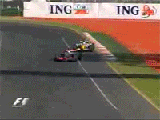I took the trouble of
making some estimations that I know will be proved wrong. These are based on a pseudo-mathematical analysis of qualy times (comparisons between team mates and performance between the sections).
From there on, fuel levels have been extrapolated to fit the 2007 strategies with a suitable coefficient and quesstimating which drivers opted for stops that aren't within that framework. Performance up until lap 26 (all top ten should've stopped by then) has been modelled with arithmetic series roughly simulating vehicle weight and simple constants have been applied to account for drivers settling on the driving line after the start. Pitstops have been accounted for, baseline speeds have been determined from relative speeds in the qualy with reference to the comparable performances in 2007.
I left vehicle interactions, the human element (driver performance) and tyre strategies out of the equations. This should mess up the results of this "prediction" nicely already, not considering true unknowns even. I only did this to see just how this sort of stuff doesn't work. Self organising maps and genetic algorithms will have to wait until I get my "nerd on", if ever.
1st Pit stop windows by TOP10 drivers:
RAI 19-20-21
ALO 16-17-18 (prob. unreliable due to tactic being outside conventional)
MAS 23-24-25 (prob. not right on account of a mistake)
KUB 21-22-23
HAM 18-19-20
KOV 19-20-21
WEB 17-18-19 (lack of comparison to team mate adds to uncertainty)
TRU 19-20-21 (lack of comparison to team mate adds to uncertainty)
HEI 23-24-25
PIQ 23-24-25
Positions after first pit stops have been made, L26 + distance to the leader
1. RAI 0:36,58.570
2. MAS +5.500
3. ALO +12.400
4. KUB +14.010
5. HAM +18.090
6. KOV +20.400
7. HEI +27.160
8. WEB +30.790
9. TRU +30.900
10. PIQ +31.760
Drivers beyond TOP10 and their effect not considered.
- Login or Register
No account yet? Sign up





